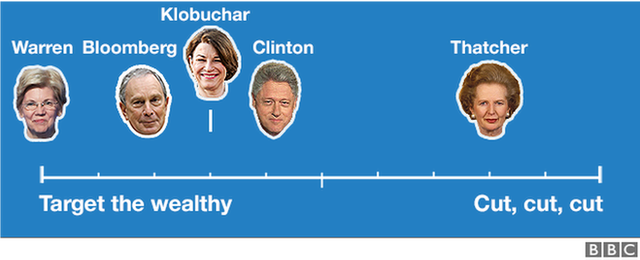US election: How left-wing is the Democratic field?
February 25, 2020
The tension between the so-called progressive wing of the party, led by Bernie Sanders and Elizabeth Warren, and the moderates like Joe Biden, Amy Klobuchar, and Pete Buttigieg is dominating the primary elections.
Let's break it down by issues and compare the current field to figures in history and leading politicians from the UK.
When there's a Democratic nominee, we will reprise the format, adding Trump and world leaders.
Taxes
Taxes will always be a hot-button political issue in the US.
Back in 1992, Bill Clinton came into office with a fairly ambitious plan to reverse many of the Ronald Reagan-era tax cuts, but he still enacted a middle-class tax cut as part of his package. Democrats today are more aggressive.
Amy Klobuchar typifies the "moderate" position of wanting to raise corporate taxes, but not back to pre-Trump levels, and ensure that all billionaires pay at least 30% of their income in taxes. Michael Bloomberg has called for a 5% surtax on income above $5m - part of a plan he says will raise $5tn.
The real action comes with those seeking funding for their more ambitious plans, however. Elizabeth Warren has proposed a tax on all wealth above $50m - property, stock, everything - that would bankroll her education and healthcare programmes.
Across the pond, Margaret Thatcher set the baseline with her conservative, tax-and-regulation-slashing agenda.
Reactions
You may like these posts
Advertisement

Advertisement

Advertisement



Advertisement
TRENDING
5/recent/post-list
Ads

Movies
5/Movies/post-list
Worlds Happening TV
BBNaija
5/BBNaija/post-list
Entertainment
5/Entertainment/post-list
Events
5/Events/post-list
Latest
5/recent/post-list
Popular Posts

Mr Macaroni’s Skit on a need to #EndSARS is so Apt Right Now
October 13, 2020





0 Comments